CAPE CANAVERAL AIR FORCE STATION, FL – SpaceX scored a spectacular launch success this evening (Dec. 3 ) when the maiden flight of their upgraded Falcon 9 rocket from Florida scorched the sky of the Florida Space Coast and successfully delivered a commercial space satellite to geostationary orbit for the first time ever – thereby revolutionizing the commercial space industry from this day forward.
The third time was finally the charm as the Falcon 9 blasted off precisely on time at 5:41 p.m. EST from Launch Complex 40 at Cape Canaveral following a pair of launch scrubs last week on Nov. 25 and Thanksgiving Day Nov. 28 caused by technical problems with the first stage engine.
The booster thundered off the pad and pierced the completely cloud free evening sky soon after sunset as the blistering roar rumbled deafeningly all across the space coast viewing area.
The rocket exhaust plume was easily visible for several minutes after liftoff of the historic mission.

The 3,138 kg (6,918 lbs) SES-8 satellite was built by Orbital Sciences for SES and is a hybrid Ku- and Ka-band spacecraft that will provide TV and communications coverage for the South Asia and Asia Pacific regions.
This new version of the Falcon 9 rocket has nearly 50% more thrust compared to the original Falcon 9.
The stakes could not have been higher for the future of SpaceX.
The firms future launch manifest of more than 50 flights for NASA and a variety of commercial entities worth billions of dollars were riding on the success of tonight’s liftoff from Cape Canaveral Air Force Station, Florida.
With 54 satellites in orbit SES is one of the largest commercial telecommunications satellite operators in the world.
The next generation Falcon 9 rocket injected the SES-8 telecommunications to its targeted geostationary transfer orbit flying 295 x 80,000 km above Earth.
A restart of the second stage engine was absolutely essential to the success of the mission since a failure to ignite would have doomed the SES-8 satellite from reaching is desired orbit since it’s a requirement for all geostationary transfer missions.
The picture-perfect flight met 100% of the mission objectives, SpaceX said in a post-launch statement.
“The successful insertion of the SES-8 satellite confirms the upgraded Falcon 9 launch vehicle delivers to the industry’s highest performance standards,” said Elon Musk, CEO and Chief Designer of SpaceX.
“As always, SpaceX remains committed to delivering the safest, most reliable launch vehicles on the market today. We appreciate SES’s early confidence in SpaceX and look forward to launching additional SES satellites in the years to come.”
Today’s launch marked SpaceX’s first commercial launch from Florida as well as the first commercial flight from Cape Canaveral Air Force Station in over five years.
Satellite operators have booked their commercial launches with other rocket companies overseas due to the high cost of other American expendable rockets.
SpaceX’s entire corporate aim has been to significantly cut the high cost of access to space.
“This is really rocking the industry. Everybody has to look out,” said Martin Halliwell, SES chief technical officer, at the prelaunch meeting with reporters including Universe Today.
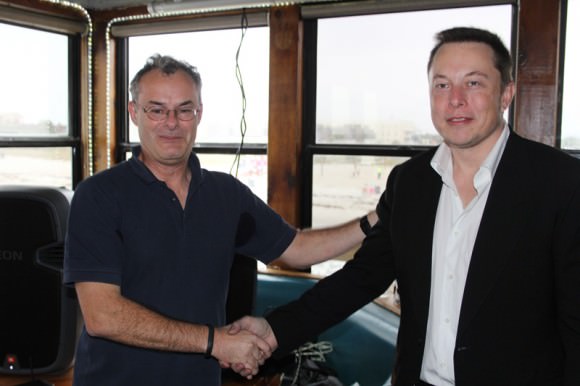
With today’s SpaceX is sure to sign even more contracts bringing additional commercial telecommunications satellite space launches back to American soil.
Approximately 185 seconds into flight, the Falcon 9’s second stage equipped with a single Merlin 1-D engine ignited.
It burned for five minutes and 20 seconds to inject SES-8 satellite into its initial parking orbit.
Eighteen minutes later the second stage engine relit for a second time and fired for just over one minute to deliver SES-8 satellite to its final geostationary transfer orbit.
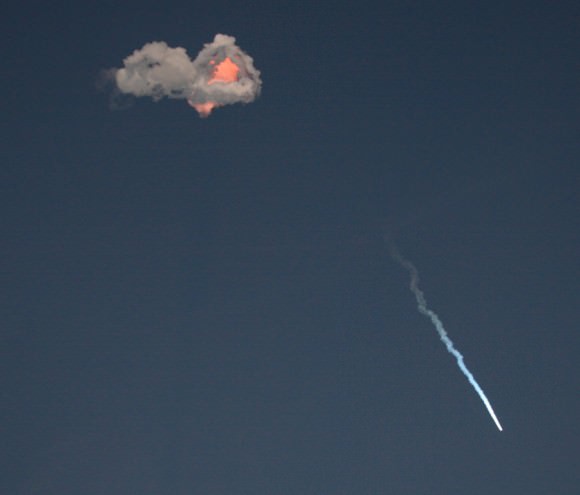
This extra powerful new version of the Falcon 9 dubbed v1.1 is powered by a cluster of nine of SpaceX’s new Merlin 1D engines that are about 50% more powerful compared to the standard Merlin 1C engines. The nine Merlin 1D engines 1.3 million pounds of thrust at sea level rises to 1.5 million pounds as the rocket climbs to orbit.
The Merlin 1 D engines are arrayed in an octaweb layout for improved efficiency.
Therefore the upgraded Falcon 9 can boost a much heavier cargo load to the ISS, low Earth orbit, geostationary orbit and beyond.
The next generation Falcon 9 is a monster. It measures 224 feet tall and is 12 feet in diameter. That compares to a 130 foot tall rocket for the original Falcon 9.
Stay tuned here for continuing SpaceX & MAVEN news and Ken’s SpaceX launch reports from on site at Cape Canaveral & the Kennedy Space Center press site.
…………….
Learn more about SpaceX, MAVEN, MOM, Mars rovers, Orion and more at Ken’s upcoming presentations
Dec 3/4: “SpaceX launch, MAVEN Mars Launch and Curiosity Explores Mars, Orion and NASA’s Future”, Kennedy Space Center Quality Inn, Titusville, FL, 8 PM
Dec 11: “Curiosity, MAVEN and the Search for Life on Mars”, “LADEE & Antares ISS Launches from Virginia”, Rittenhouse Astronomical Society, Franklin Institute, Phila, PA, 8 PM
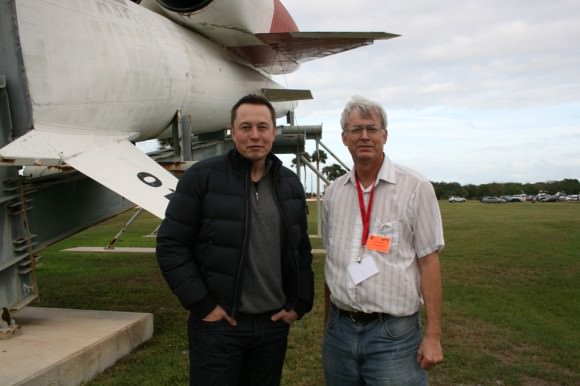

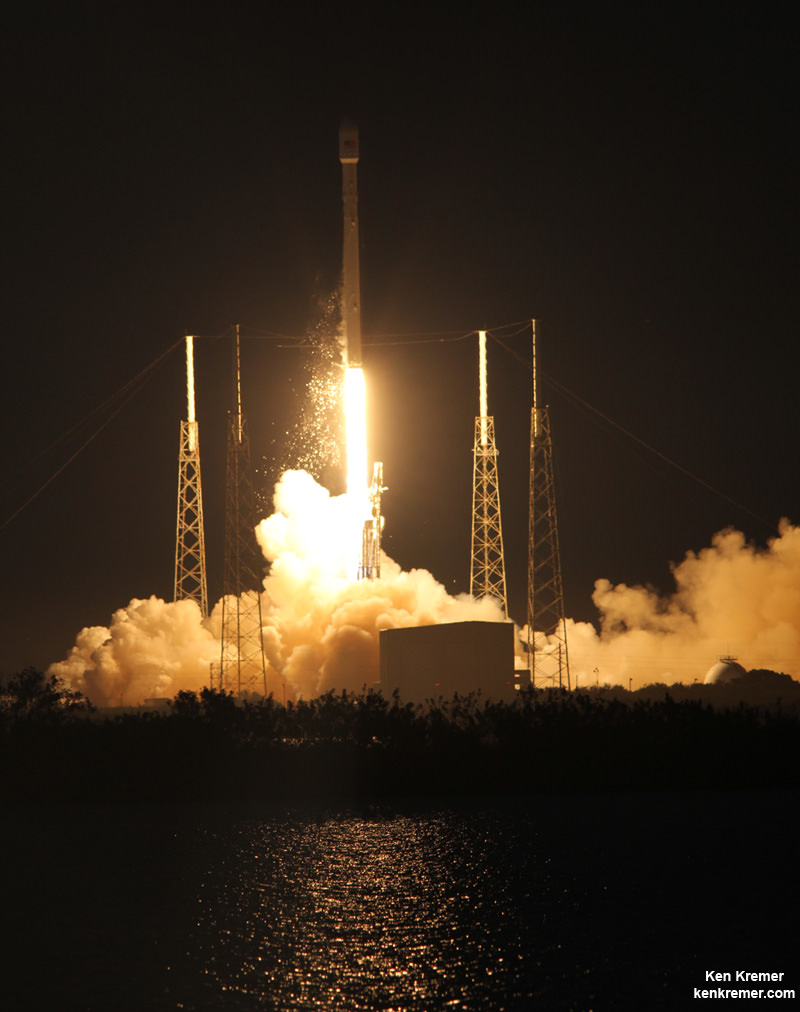
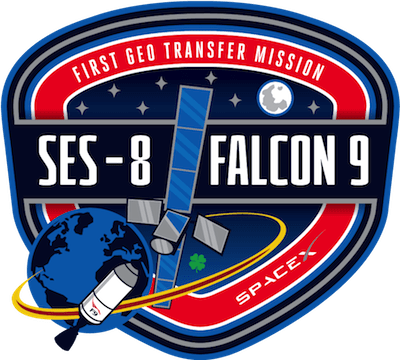
What does this do for the price per pound of sending things into orbit?
Even though they said there will be no stage 1 return tests, I bet they were at least trying controlled descent, there was something happening with stage 1 shortly after separation, but the ground camera quickly switched to view of stage 2 engine.
Frankly, I think they just left the controlled descent software active, even though there wasn’t enough fuel left to carry the process through to completion. So immediately after separation, just as happened in the CASSIOPE launch in September, the first stage reoriented itself for retro-fire. It simply couldn’t actually perform the retro-fire this time.
is there anything from SpaceX on this? I know they don’t like to talk about their more “fanciful” experiments as their detractors love to find failures to harp on, but it would be interesting to know if they attempted controlled landing experiments and if so, what challenges and unexpected results they obtained. Maybe vehicular behaviors that were unmodelled and unpredicted? or maybe things worked better than expected?
They have been quite mum about it. There is next to nothing official, but here are what I consider to be the fairly solid tidbits:
(1) After this launch, Elon Musk said he was now considering a repeat of the previous land-on-water test during the next launch (ThaiCom). This statement was reported by USA Today. Speculation: This test would include the landing legs, even though it would be into the sea, because the legs will presumably stabilize the stage during descent.
(2) The first stage definitely reoriented itself after separation this time around, but the reason was apparently that they wanted to see what would happen to the stage in one of the worst cases, where the stage was correctly oriented for return, but no retrofire was conducted. What happens when the stage is not correctly oriented is already known from the earlier Falcon 1.0 flights.
(3) There has been nothing said publicly, one way or the other, regarding the earlier statement by Musk that they wanted to go all the way to a controlled landing on land for the next ISS supply flight, currently scheduled for late February. They haven’t dropped it, nor have they positively confirmed it. A lot depends on the FAA giving them permission to try and land the stage.
Do some searching on youtube and you can find home video of the first stage firing its gas thruster for reorientation right after stage separation. It’s a very nice view because of the time of day the launch was. You can even see the fairing separation.
Also, no they won’t use the legs on the next flight. The legs each weigh a couple thousand pounds and they already promised ThaiCom that they wouldn’t do anything to reduce the performance of the stage. As it stands they have a lot of work ahead of them to prove that reserving fuel for the return burn is no risk to the mission.
Also did you notice, only one MECO, where previous flights have cut off two engines early? That says the stack was heavy at separation, or else they’d have violated acceleration limits.
The article is very right about the cost factor. It is the same factor that deterred many space faring nations from investing more into the field. More private companies should come forward with even deeper space missions. May be even sample return missions must be planned. http://www.iampleasant.com/2013/11/mars-orbiter-mission-a-step-in-the-right-direction-for-india/
I watched it go up from my home on Merritt Island. Much bigger show than Atlas 5 or Delta IV heavy. Big rooster tail. The contrail was nice when it got up high where the sun could give it a nice orange/pink color. I can hardly wait to see and hear/feel what a Falcon Heavy will be like.
One sanity check, though: SpaceX has now proven that they can launch a satellite into geosynchronous transfer orbit, the most profitable sector of the commercial satellite market. Now that the naysayers cannot say “Wait a minute, they haven’t proven they can even launch such satellites!”, they will fall back to their next defense, which will be “Wait a minute, they haven’t proven they can even launch so many satellites reliably or even on time!” There is a lot of money riding on that business, and it is a time-honored tradition in established business to use FUD (fear, uncertainty and doubt) to slow down customers going to their new competition. They make valid points, of course, but you have to keep the noise they make in perspective.
Another thing that must be taken into account: SpaceX has stated publicly, over and over again, that it is not their purpose to simply compete with ULA, Arianespace, or even the Chinese. It is their purpose to reduce the cost of getting to space so that they can get people up there, and eventually to Mars. Launching satellites for people serves two purposes: perfecting their technology, and paying the bills along the way. This is not a business oriented around simply making a boat-load of cash. Nothing I have seen so far says that Elon Musk is into this only for the money.
Therein lies the real risk to commercial customers: the possibility that their needs may take a back seat to SpaceX’s end goals.
Ooooor Elon just rides the hype wave and let’s himself be celebrated as a “visionary” who “finally opens up the final frontier” (real words by real Internet commentators) to get more contracts.
Considering how the whole Hyperloop stunt turned out, I know which possibility I pick…
What “hyperloop stunt” are you referring to? As far as I recall he drew up plans, said here is a better idea I’m too busy to do this I hope someone else builds the thing and went back to cranking out EV’s & shooting stuff into space.
I think it stops being hype when you actually do it. That was Rick’s point. His other point was that the more launches that are executed, the flimsier the arguments against SpaceX get. Case in point, your post.
The Price for pound of both versions of the Falcon 9 is in the same range as the ultra low cost rockets from India. The Falcon Heavy should be cheaper (per pound) for a fully loaded rocket than any other rocket ever made (matching or perhaps slightly exceeding the fantastic Russian/Ukrainian Zenit rockets). Zenit rockets have a rather low relability though, especially in the past few years. Hopefully the Falcon Heavy will match them in price will maintaining high quality assurance standards.
And what of the price per pound if/when they can land the stage one boosters.
They plan to offer flights on reused first stages for 25% less.
Congratulations Space-X! This is just the boost needed, what the doctor ordered, for America’s near flat-lined space program! I’ll wager the other major players are intently studying your manufacturing and procurement techniques and are turning green with envy! Here’s hoping they’ll learn something good from you and take steps to reduce their mission costs…. a ripple through the industry heard worldwide!
In addition to the great work by SpaceX I think SES also deserves credit for the guts it took to risk a satelite on a new rocket. All too many companies and governments say they want cheaper launch prices but are not willing to launch on a rocket until it is proven by someone else.
I would also say that this is a great vindication of NASA COTS, a small initial investment by NASA and a contract as a foundation customer allowed SpaceX to close a business case for a new rocket. Looking at the launch manifest of SpaceX and the taxes they will pay in profit and other taxes the state and federal governments may well make a profit from the COTS funding.
there was discussion that the first stage might contain a version of the “grasshopper” technology just to see how it would perform after stage separation. Did this get attempted for this flight?
No, for this flight all fuel was reserved for performance. Depending on certain variables they might try something on the next flight, or they might not. But for sure they will for the flight after that- this launch will happen in February or March of next year.
I’m no expert but that fire trail off the back off Falcon 9 looked so much more powerful than anything I’ve seen in the past. And the fact that they’ve iterated the design so quickly all ready says so much for SpaceX. They’re disrupting the industry with Falcon 9. When Falcon Heavy comes out … oh Nelly. Not to mention the incremental changes they discover process improvement and upgrades during the manufacturing process. Scary.